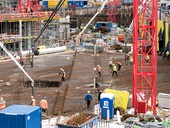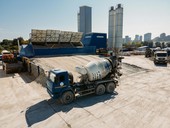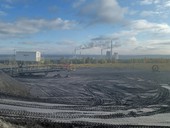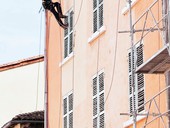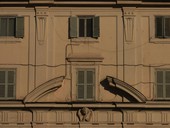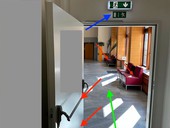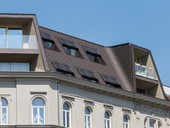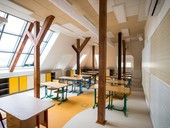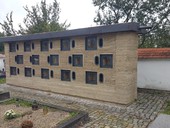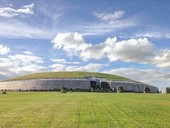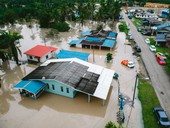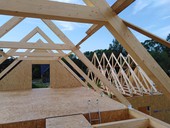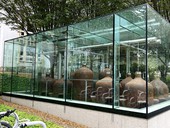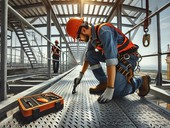In 2015, the preparation of a new generation of the Eurocodes was initiated, with the implementation in Slovakia anticipated by 2028. The notable update introduced in the Eurocode 2 is a revised methodology for the design of the anchorage of reinforcing steel in concrete structures. This article presents a comparative analysis of the design approaches and the required anchorage lengths specified in the current and upcoming version of the Eurocodes 2.
Archiv článků od 17.12.2024 do 11.8.2025
This paper deals with the use recyclate as a partial or complete substitute for natural aggregates for the production of concrete. However, the current legislation in the EU and the Czech Republic allows this use only to a very limited extent. The text will describe the current situation in the Czech Republic and the directions of further development of related standards to extend the existing possibilities of using recyclates for concrete production.
The aim of the methodology is to establish a procedure for the safe use of fly ash from coal combustion in construction products. The development of this methodology was part of project no. FW01010195, titled “Advanced Manufacturing Technologies for the Strategic Utilization and Storage of By-Products of Energy Production (BEP)”. The methodology is intended to serve as a basis for decision-making regarding the handling of these materials for companies engaged in the production of construction products containing fly ash, state administration officials, the Czech Environmental Inspectorate (ČIŽP), certification bodies, regulatory authorities, and other relevant stakeholders.
This article focuses on the composition and restoration of plasters of historical buildings, carried out since the 20th century, especially from its second half until today. The binders, admixtures, and additives used for plasters in the past are described, and the differences in their properties compared to those of current materials are discussed. The principles of plaster restoration using various methods of preparing plaster mortar mixtures are described. Attention is also paid to the types and properties of plasters for damp masonry containing water-soluble salts. Disagreeing opinions on restoration from the perspective of architectural heritage care and technologists are also discussed.
This article focuses on the composition and restoration of plasters of historical buildings, carried out since the 20th century, especially from its second half until today. The binders, admixtures, and additives used for plasters in the past are described, and the differences in their properties compared to those of current materials are discussed. The principles of plaster restoration using various methods of preparing plaster mortar mixtures are described. Attention is also paid to the types and properties of plasters for damp masonry containing water-soluble salts. Disagreeing opinions on restoration from the perspective of architectural heritage care and technologists are also discussed.
The article deals with a specific form of funerary architecture, namely contemporary columbaria made of earth. After summarizing the specifics of earthen funerary architecture, the article presents examples of contemporary earthen columbaria realizations in Europe. The description includes information about the authors, the date of construction, dimensions, general characteristics and photographs of these selected projects. The article deals in detail with the architectural form, spatial arrangement, material solutions, conceptual approach to the design and the actual construction of the building.
This article addresses a crucial aspect of fire safety in buildings – the accessibility and unobstructed condition of escape routes. Based on real-world examples, it highlights severe deficiencies such as incorrectly mounted fire doors, missing door closers, and the placement of combustible furniture in protected escape routes. The text explains the applicable legal and technical requirements (e.g., Decrees No. 23/2008 Coll., 202/1999 Coll., Government Regulation No. 101/2005 Coll., and ČSN 73 0835) and provides practical recommendations for facility managers, building administrators, and fire safety professionals. The aim is to reduce evacuation risks and ensure compliance with fire safety legislation.
The second and final part of the article on the design of loft extensions and superstructures in masonry buildings deals with other possibilities of increasing the load-bearing capacity of existing wooden floor structures. It also discusses the reinforcement of reinforced concrete ceilings and ceiling structures with rolled steel profiles. Finally, the possibility of increasing the clear height of the loft space and the special features of superstructures.
This paper begins the first part of a series of articles on the design of loft extensions and superstructures in masonry buildings. The first part deals with the problem of loading of floor structures and the possibilities of further action in cases where the floor structure is structurally unsuitable for the new purpose. Subsequently, the possibilities of increasing the load-bearing capacity of wooden ceilings are described. This is done by changing the structural system, inserting a new ceiling slab, and by coupling the original ceiling with an additional structure.
Columbaria, serving as repositories for urns with the ashes of the deceased, represent a significant element of funerary architecture, whose form has evolved considerably throughout history. From ancient Roman structures, characterized by the regular division of niches for urn placement, to contemporary minimalist, eco-friendly, and digitally connected burial spaces, columbaria reflect changes in approaches to cremation and funerary culture in general. This article presents the architectural development of columbaria, emphasizing material solutions, spatial organization, and technological innovations.
Funerary architecture, in conjunction with funeral rituals and religious traditions, has undergone numerous transformations over the centuries. These changes have been influenced by technological advancements, shifts in the perception of death and the afterlife, as well as urban and hygienic requirements of different historical periods. This article outlines the historical development of funerary architecture, its main forms, social and religious aspects, and presents the most significant funerary structures that have shaped history and continue to influence contemporary approaches to funerary architecture. The primary focus is on the diversity of architectural forms of funerary structures, their symbolism, and their role in the collective memory of society.
The fourth and last part of the series of articles on the problem of masonry buildings situated in floodplains deals with the problem of loading of buildings during the passage of a flood wave. Specifically, the calculation of the load from the vertical buoyancy of water from the flood wave, the load from the dynamic pressure and the load from the dynamic effect of a floating object.
The third part of the series of articles on the problems of masonry buildings located in flood-prone areas deals with the possibilities of rehabilitation of damp masonry partitions after the water from the flood wave has hit. Furthermore, it deals with the issue of underground structures and the flood area, which is also a submerged area. The third part concludes with an introduction to the issue of loading of buildings during the passage of a flood wave.
The second part of the first series of articles on the problems of masonry buildings located in floodplains deals with the peculiarities of historic and listed buildings. It also deals with the treatment of expansion joints, protection against water pressure and the treatment of the internal distribution of technical equipment of buildings. Last but not least, it deals with the issue of rehabilitation of buildings after a flood wave.
This paper begins the first part of a series of articles on the issue of masonry buildings located in floodplains. The first part deals with the general issue of securing existing buildings against the effects of a flood wave, as well as specific possibilities of implementing additional structural modifications to existing buildings. Both in terms of the internal layout and the possibilities of static securing of the supporting structures.
Moisture affects the strength of wood. The strength decreases with increasing humidity. Excessive moisture in wood allows the growth of wood-decay fungi. They attack the building covertly and can cause great damage before they are detected. Wood can be protected against wood-decay fungi by impregnation. Its use in residential buildings is problematic. That is why structural protection is used, i.e. incorporating the wood into the building in such a way that it does not get wet or even soaked and its natural drying out is ensured. During the lifetime of a building, timber can be threatened by high humidity in the structure, condensation, water vapour, leakage or failure of water supply systems and, for example, flooding. It is wise to measure the moisture content of timber in structures and to react in good time to excessive moisture content. Unfortunately, there are not many ways to do this. The method described in this article addresses the monitoring of moisture in timber enclosed in structures.
The paper deals with the design of recycled asphalt mixtures for the bound base layers of pavements. These mixtures are made up of almost 100% reclaimed asphalt mixture adjusted by crushing to a suitable wide fraction. Suitable binder added to the recycled asphalt mixture or heated to a low temperature or is processed by a combination of these technological procedures. The research described in the contribution follows on from the newly created standard ČSN 73 6147 “Recycling of structural layers of roads in the cold”.
This paper focuses on fire safety solutions for warehouses according to ČSN 73 0845. For comparison, the requirements set by the legislation in Portugal and Canada are analysed, as well as the requirements set by the NFPA (The National Fire Protection Association). The different approaches are compared and the most important differences are mentioned, especially in relation to current trends in warehousing. Finally, a software tool created in the Python programming language called “Warehouse Operations Group” is introduced. This tool is used to classify the fire compartment of a warehouse into a group of warehouse operations according to the method set out in Annex A of ČSN 73 0845. The process of determination simplifies and eliminates any errors that may enter into the calculation.
This paper presents the results of an experimental investigation into fully transparent bonded joints for load-bearing glass structures. The research specifically focused on the surface properties of glass that affect the load-bearing capacity of the joints, such as surface energy, wettability, and roughness. It also discusses the differences between the tin and air sides of the glass sheets.
The findings are supported by tests conducted at the Faculty of Civil Engineering at CTU between 2021 and 2023. Tensile and dynamic tests of the selected adhesive LOCTITE® EA 9455 as well as shear tests of single-shear glass-to-glass joints, were evaluated, with a focus on the load-bearing capacity of the joints at elevated temperatures.
The paper concludes with a summary of the results and suggests their implications for engineering practice.
The article focuses on the importance of regular inspections and maintenance of smaller steel structures, such as roof walkways, fire escape stairs, or railings, from the perspective of applicable legal regulations and technical standards. It highlights the key requirements of ČSN 73 2604 and other legislative measures that ensure the safety and long-term reliability of these structures. The text also provides practical advice on inspection procedures, inspection frequency, and inspector qualifications. This article serves as a valuable guide for property owners and professionals in occupational health and safety (OHS) and facility management.
zpět na aktuální články
